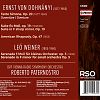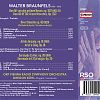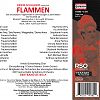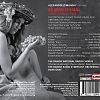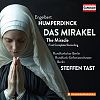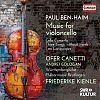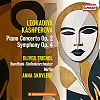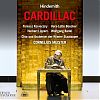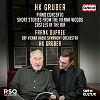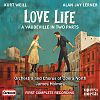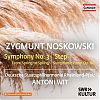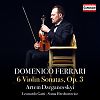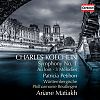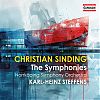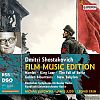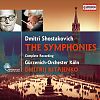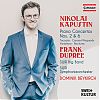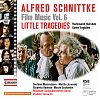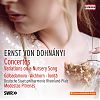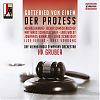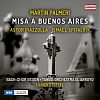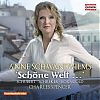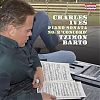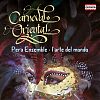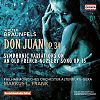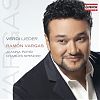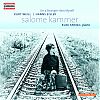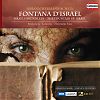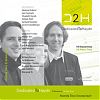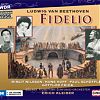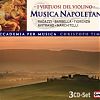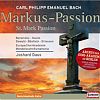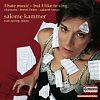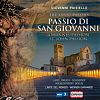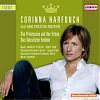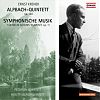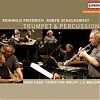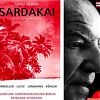cd

ERNST VON DOHNÁNYI
ORF Vienna Radio Symphony Orchestra · Roberto Patrnostro
Ernst von Dohnanyi was one of the most versatile and influential musicians of his time but his works are now seldom played. A gap which Capriccio want to fill now with this already fifth recording of his late romantical, sensual music, deeply rooted in the Austro-German
classical tradition. An appetizer is the overture of the one-act opera Tanta Simona, which has plenty of that Italian flair to show for that runs through the opera’s plot. After its premiere in 1910, the Suite in F-sharp minor Op.19 became one of the most performed Dohnányi’s works, whereas the American Rhapsody Op.47, which is full of quotations with american folk melodies, was his last orchestral work, first performed in 1954 at Ohio University. Finally his 8 years younger colleague Leó Weiner shows us in his early composition, the Serenade in F minor (1906) apart from the influence of the German and Austrian romantics, typical Hungarian colors and rhythms.
Hörprobe
Weitere Bilder

Walter Braunfels
ORF VIENNA RADIO SYMPHONY ORCHESTRA · GREGOR BÜHL
Walter Braunfels is a composer whose music died twice: Once when the Nazis declared his music “degenerate art”. Then again when post-war Germany had little use for the various schools of tonal music; when the arbiters of taste considered any form of romantic music – almost the whole pre-war aesthetic – to be tainted. This already 9th release of Capriccio’s Braunfels Edition shows us also an open minded composer who experimented with Jazz elements in his Divertimento for radio-orchestra in 1929.
Hörprobe
Weitere Bilder
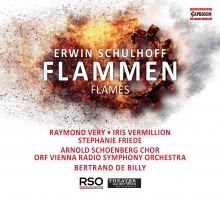
ERWIN SCHULHOFF
RAYMOND VERY · IRIS VERMILLION · STEPHANIE FRIEDE · ARNOLD SCHOENBERG CHOR · ORF VIENNA RADIO SYMPHONY ORCHESTRA · BERTRAND DE BILLY
Musical Tragicomedy in 2 Acts with 10 Scenes WV 93 (1928-32)
Libretto von / by: Max Brod · Nach / after: Karel Josef Beneš
Don Juan RAYMOND VERY
La Morte IRIS VERMILLION
Eine Frau / Eine Nonne / Margarethe / Donna Anna STEPHANIE FRIEDE
1. Frauenschatten GABRIELA BONE
2. Frauenschatten NINA BERNSTEINER
3. Frauenschatten ANNA PESHES
4. Frauenschatten CHRISTA RATZENBÖCK
5. Frauenschatten HERMINE HASELBÖCK
6. Frauenschatten ELISABETH WOLFBAUER
Der Komthur Salvador FERNÁNDEZ-CASTRO
Pulcinella KARL-MICHAEL EBNER
Pantalone ANDREAS JANKOWITSCH
Harlekin MARKUS RAAB
ARNOLD SCHOENBERG CHOR
(Einstudierung / Chorus Master: Erwin Ortner)
Jazzband: Mitglieder des Orchesters der Vereinigten Bühnen Wien
ORF VIENNA RADIO SYMPHONY ORCHESTRA · BERTRAND DE BILLY
In the 1920s and 1930s, there was a multi-faceted musical scene in culturally flourishing Czechoslovakia. When we take a look at the works by e.g. Pavel Haas, Gideon Klein, Hans Krása, Viktor Ullmann or Erwin Schulhoff, we can perceive a stylistically very similar course, conceivable against the given background as a ‘Prague School’ (as a counter-movement to the ‘Viennese School’). In Schulhoff’s early works, the features are a late Romantic approach influenced by Reger that later developed with an emphasis on rhythm in the direction of Expressionism and Neo-Classicism, also including jazz elements. The starting point is the ‘Don Juan’ story, but the underlying idea in Beneš’ and Schulhoff’s work is not to present the colourful seducer, but the fate of a man driven by his desires and needs who cannot even remotely find happiness and peace in constancy. In his opera, Schulhoff brilliantly manages to find a different dramaturgical approach, on the one hand, and at the same time to pay a kind of alienated homage to Mozart’s work, on the other.
Hörprobe
Weitere Bilder

Alexander Zemlinsky
JAMES O’NEAL · MONTE PEDERSON · NINA WARREN · PHILHARMONISCHES STAATSORCHESTER HAMBURG GERD ALBRECHT
König Kandaules: JAMES O’NEAL
Gyges: MONTE PEDERSON
Nyssia: NINA WARREN
Phedros: KLAUS HÄGER
Syphax: PETER GALLIARD
Nicomedes: MARIUSZ KWIECIEN
Pharnaces: KURT GYSEN
Philebos: SIMON YANG
PHILHARMONISCHES STAATSORCHESTER HAMBURG
GERD ALBRECHT, Dirigent / conductor
Hörprobe
Weitere Bilder

Alexander Zemlinsky
EVA JOHANSSON · KURT WESTI · PER ARNE WAHLGREN · THE DANISH RADIO SYMPHONY ORCHESTRA · HANS GRAF
A Fairy-tale Opera in a Prologue and three Acts
Text: Maximilian Singer nach / after: Holger Drachmann „Der var engang“
Prinzessin / Princess: EVA JOHANSSON
Prinz / Prince: KURT WESTI
Kaspar: PER ARNE WAHLGREN
König / King: AAGE HAUGLAND
Ein Freier / A Suitor: OLE HEDEGAARD
Ein Schweizer / A Commissionaire: GUIDO PAEVATALU
Kommandant / Commander –
Herold / Herald: CHRISTIAN CHRISTIANSEN
Erste Hofdame / First Lady In Waiting: SUSSE LILLESOE
THE DANISH NATIONAL RADIO CHORUS
(Choreinstudierung / Chorus Master: Kaare Hansen)
THE DANISH RADIO SYMPHONY ORCHESTRA
HANS GRAF, Dirigent / conductor


